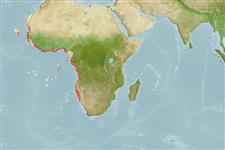Elasmobranchii (tubarões e raias) (sharks and rays) >
Carcharhiniformes (Ground sharks) >
Pentanchidae (Deepwater catsharks)
Etymology: Galeus: galeos, a small shark or dogfish according to Aristotle and others (See ETYFish); polli: In honor of Belgian ichthyologist Max Poll (1908-1991), who first brought attention to this species (See ETYFish).
Eponymy: Dr Max Fernand Leon Poll (1908–1991) was a Belgian ichthyologist, and ‘connoisseur of the fish fauna’. [...] (Ref. 128868), visit book page.
Environment: milieu / climate zone / depth range / distribution range
Ecologia
marinhas batidemersal; intervalo de profundidade 200 - 720 m (Ref. 244), usually 300 - 500 m (Ref. 9996). Deep-water; 26°N - 26°S
Eastern Atlantic: southern Morocco to Namibia (Ref. 244).
Length at first maturity / Tamanho / Peso / Idade
Maturity: Lm 30.5 range ? - ? cm
Max length : 45.0 cm TL macho/indeterminado; (Ref. 5578)
Descrição breve
Chaves de identificação | Morfologia | Morfometria
Espinhos dorsais (total) : 0; Espinhos anais: 0. A long-nosed, dwarf catshark with a narrow head, large eyes, and small labial furrows; upper caudal fin margin with prominent crest of enlarged sawtooth-like denticles (Ref. 5578). Pale brown, paler ventrally; juveniles have dark saddles that become less prominent in adults (Ref. 5510).
Found on the outermost shelf and upper slope. Feeds mainly on small bony fish, including lanternfish, hakes, grenadiers, rockfish and lightfish, also squid and crustaceans. Ovoviviparous (Ref. 50449). Tolerates bottom with low oxygen levels (Ref. 5578). Utilized fresh (Ref. 244).
Eggs are sometimes fertilized internally by accident via close apposition of gonopores in otherwise oviparous fishes and may be retained within the female's body and complete some of the early stages of embryonic development. Embryos feed solely on yolk (Ref. 50449). Bears up to 12 young (Ref. 5578), size at birth 11-12 cm (Ref. 5510).
Compagno, L.J.V., 1984. FAO Species Catalogue. Vol. 4. Sharks of the world. An annotated and illustrated catalogue of shark species known to date. Part 2 - Carcharhiniformes. FAO Fish. Synop. 125(4/2):251-655. Rome: FAO. (Ref. 244)
Categoria na Lista Vermelha da IUCN (Ref. 130435: Version 2024-2)
Ameaça para o homem
Harmless
Utilização humana
Pescarias: pouco comercial
Ferramentas
Relatórios especiais
Descarregue XML
Fontes da internet
Estimates based on models
Preferred temperature (Ref.
123201): 6.7 - 11, mean 8.7 °C (based on 38 cells).
Phylogenetic diversity index (Ref.
82804): PD
50 = 0.5000 [Uniqueness, from 0.5 = low to 2.0 = high].
Bayesian length-weight: a=0.00229 (0.00139 - 0.00376), b=3.06 (2.92 - 3.20), in cm total length, based on LWR estimates for this species & (Sub)family-body (Ref.
93245).
Nível Trófico (Ref.
69278): 4.2 ±0.7 se; based on diet studies.
Resiliência (Ref.
120179): Baixo, tempo mínimo de duplicação da população 4,5 - 14 anos (Fec=12).
Fishing Vulnerability (Ref.
59153): Low to moderate vulnerability (35 of 100).
Nutrients (Ref.
124155): Calcium = 10.4 [1.8, 67.5] mg/100g; Iron = 0.351 [0.075, 1.198] mg/100g; Protein = 17 [14, 20] %; Omega3 = 0.218 [0.089, 0.525] g/100g; Selenium = 6.92 [2.23, 20.67] μg/100g; VitaminA = 21.2 [4.5, 99.2] μg/100g; Zinc = 0.409 [0.190, 0.785] mg/100g (wet weight);
